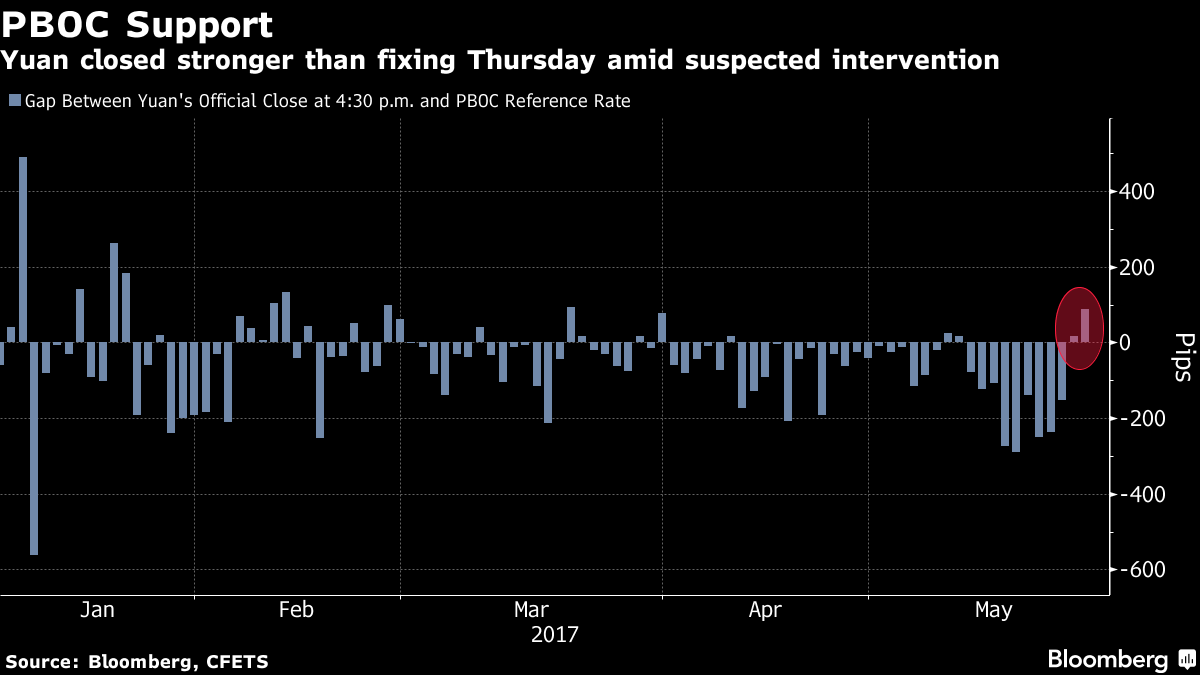China is considering changes to the way it calculates the yuan'sdaily reference rate against the dollar, a move that's likely toreduce exchange-rate volatility while undermining efforts toincrease the role of market forces in Asia's largest economy.
|Policy makers may add a “counter-cyclical factor” to the yuan'sdaily fixing, according to a government statement Friday, whichconfirmed an earlier report by Bloomberg News. Analysts said thechange would give authorities more control over the fixing andrestrain the influence of market pricing.
|While a more tightly managed currency could provide Chinabreathing room to push forward with a deleveraging campaign that'spopular among foreign investors, it would mark a step back fromPresident Xi Jinping's 2013 pledge to give markets a central role.The central bank's existing fixing system won internationalplaudits for being market-oriented and helped the yuan gain a spotin the IMF's basket of reserve currencies.
|“The counter-cyclical adjustment factor sounds like an increasedrole for the fixing to be nudged away from where markets would setit,” said Sean Callow, a senior currency strategist at WestpacBanking Corp. in Sydney. “The authorities' actions give theimpression that they are more worried about yuan stability thandeclared in their public statements.”
|Propping up the yuan has been a policy priority this year asChinese authorities try to stem capital outflows and preventfinancial shocks before an important leadership reshuffle in theruling Communist Party at the end of 2017. The stakes haveincreased in recent weeks after the regulatory clampdown onleverage roiled domestic bond and equity markets.
|Under the new reference rate formula communicated to lenders bythe People's Bank of China this week, institutions that providequotes for the fixing will add a counter-cyclical factor to theirexisting models, which take into account the previous day'sofficial closing price at 4:30 p.m. local time and changes inbaskets of currencies, according to people familiar with thematter, who asked not to be identified because the matter isprivate. Banks are currently tweaking and testing their models andwill start providing quotes using the new system soon, the peoplesaid.
|China's foreign-exchange market can be driven by irrationalexpectations, resulting in “unreal” supply and demand thatincreases the risk of overshooting, according to an officialstatement on Chinamoney.com, which is run by China Foreign ExchangeTrade System. The counter-cyclical factor may ease “herd actions”and help guide investors to pay more attention to economicfundamentals, according to the statement.
|The yuan is restricted to moves of no more than 2% on eitherside of the reference rate.
|For China's government, the existing market-based fixingsystem's downside is that it makes the exchange rate more difficultto control. The yuan's 6.5% slide in 2016 created a vicious circleof capital outflows and bets on further currency weakness,prompting officials to burn through more than $300 billion offoreign-exchange reserves and introduce tighter capitalcontrols.
|Authorities may see the new fixing formula as a cheaper way tostabilize the yuan. Officials have already used the reference rateto guide the currency higher in recent weeks, setting the fixing atlevels that were consistently stronger than analysts predicted.
|“The PBOC has been fixing with a major dose of discretion,” saidSue Trinh, head of Asia foreign-exchange strategy at RBC CapitalMarkets in Hong Kong. “We can consider this counter-cyclicaladjustment factor as using that discretion.”
|While the yuan has fluctuated in a narrow band around 6.9 perdollar for most of this year, the currency strengthened over thepast two days amid suspected government intervention. The yuangained 0.1% to 6.8622 per dollar as of 5:57 p.m. local time Friday,heading for the biggest two-day advance since late March.
|By taking steps to scale back the market's role in the fixingformula, authorities may undermine efforts to make the currencymore freely traded, according to Tim Condon, head of Asia researchat ING Groep NV in Singapore.
|“If the yuan endgame is a free float like the other majorcurrencies, refining the PBOC fixing mechanism is a retrogradestep,” he said.
|
Bloomberg News
|Copyright 2018 Bloomberg. All rightsreserved. This material may not be published, broadcast, rewritten,or redistributed.
Complete your profile to continue reading and get FREE access to Treasury & Risk, part of your ALM digital membership.
Your access to unlimited Treasury & Risk content isn’t changing.
Once you are an ALM digital member, you’ll receive:
- Critical Treasury & Risk information including in-depth analysis of treasury and finance best practices, case studies with corporate innovators, informative newsletters, educational webcasts and videos, and resources from industry leaders.
- Exclusive discounts on ALM and Treasury & Risk events.
- Access to other award-winning ALM websites including PropertyCasualty360.com and Law.com.
*May exclude premium content
Already have an account? Sign In
© 2024 ALM Global, LLC, All Rights Reserved. Request academic re-use from www.copyright.com. All other uses, submit a request to [email protected]. For more information visit Asset & Logo Licensing.







